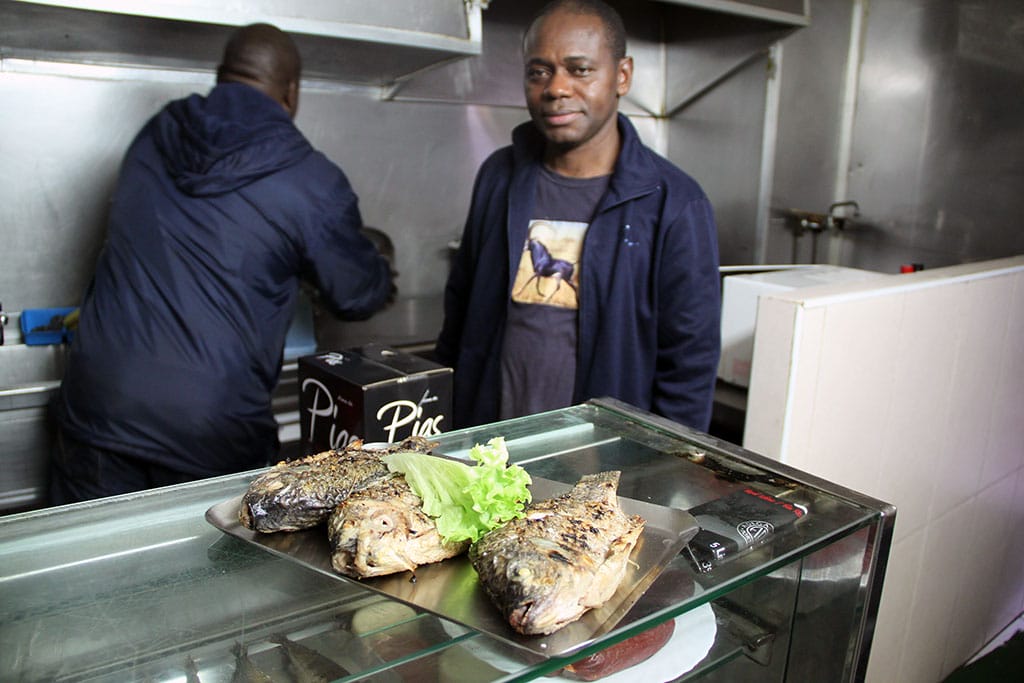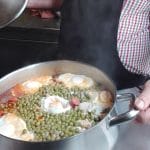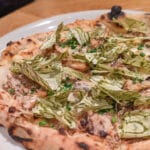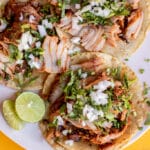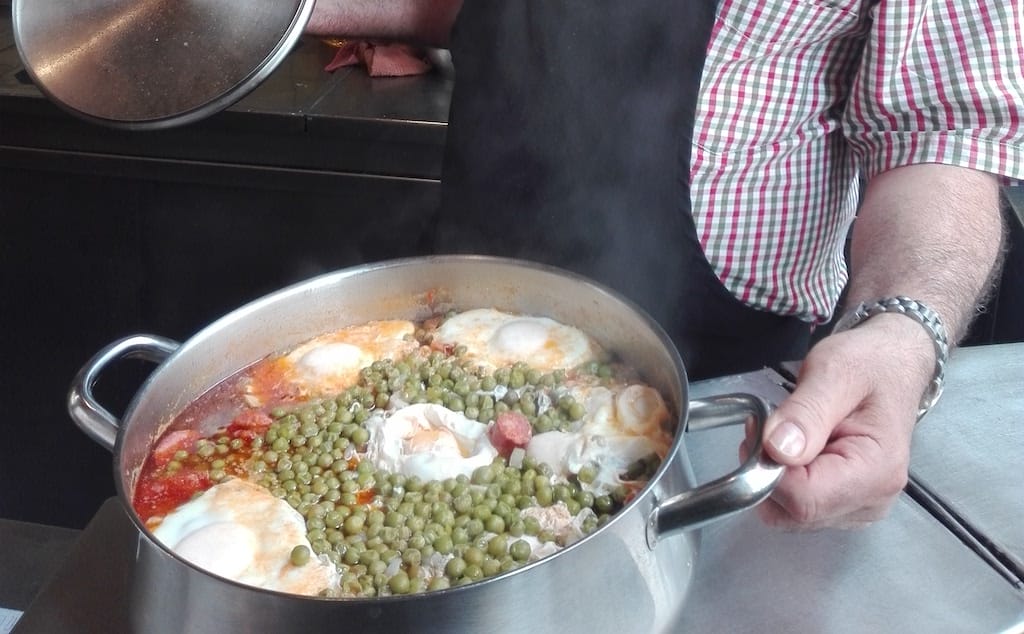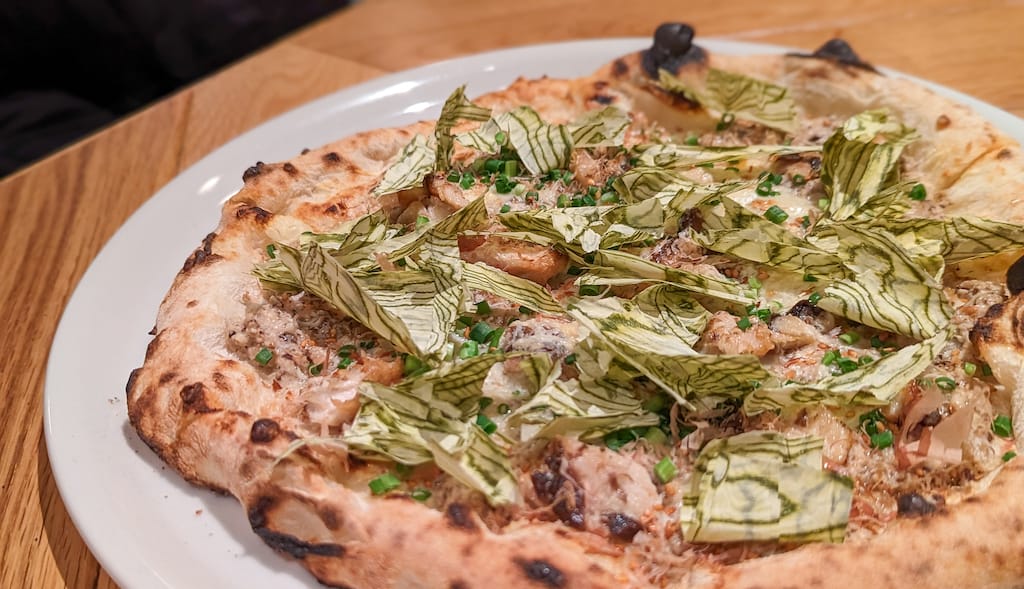Update: This spot is sadly no longer open.
Palanca Gigante is an Angolan tasca in multicultural Mouraria, Lisbon’s medieval downtown district. The restaurant is named after a critically endangered species of antelope (the palanca negra gigante, or giant sable antelope) that was adopted as an Angolan national symbol after that country’s independence from Portugal in 1975. Though regular Portuguese tascas – no-frills eateries – in Lisbon are far less endangered, it is harder to find authentic food from Portugal’s former colonies at such approachable prices in the city center.
The two-room, bare-bones eatery is open every day, serving up classic Angolan dishes amid colorful paintings under bright fluorescent lighting. Its most popular dish is muamba, made with chicken (or better yet, hen meat) marinated with garlic, lemon juice, tomato and gindungo (a type of chili pepper), cooked in a deep pan with a lot of palm oil, onions and okra. What makes the muamba so special at Palanca Gigante is its peanut seasoning, whose recipe is a carefully kept house secret. The sweet flavor contrasts beautifully with the bitter vegetables.
Muamba, as well as other stews on offer, is usually accompanied by funge, a kind of creamy polenta made mainly from cassava. Funge became a classic element of Angolan gastronomy as a result of colonization, after the dish was introduced to Africa by the Portuguese in the 16th century. This cheap and nourishing root, originally from Brazil, was used to feed people on slave-trading ships and was later, in the 18th century, successfully incorporated into the Angolan agricultural system.
The restaurant’s menu, devised by owner Duarte, also features various petiscos, or small plates (similar to Spanish tapas), which reflect the historical and culinary interrelationship between Portugal and Angola. These include moelas, a chicken gizzard stew with a very rich sauce that is typical of both Portugal and Angola; Portuguese chouriço sausages; and Angolan-style cacussos fritos (small fried fish, such as river tilapia) and sumatena (roasted dried fish), which are sourced from an Angolan supplier in Lisbon. There is also bean soup and, among the main courses,  calulu de peixe – a dish made from dried fish (usually sea bream), garlic, okra and sweet potato or spinach – which is popular in Angola as well as on the islands of São Tomé and Príncipe.
calulu de peixe – a dish made from dried fish (usually sea bream), garlic, okra and sweet potato or spinach – which is popular in Angola as well as on the islands of São Tomé and Príncipe.
Duarte learned how to cook from his relatives in the Angolan capital of Luanda in the 1990s, but he never shared his culinary knowledge until he opened Palanca Gigante six years ago. He originally moved to Lisbon to escape the Angolan civil war, which ended only in 2002, and got a job on a building site. “That was the easiest job I could find at the time,” he says. “But then the construction industry was declining all over the city, so I decided to open a restaurant.”
From that moment on, that familiarly enticing smell of muamba would waft through this hidden alley, reaching the other backstreets of Mouraria. In the beginning, the restaurant was only popular among the Angolan community, but nowadays, due to the rehabilitation of the neighborhood, a new clientele is discovering it. “Mouraria has been improved; now we have customers from all over the world, and both residents and tourists are coming to taste our cuisine,” Duarte says. Luckily for him, his rents have stayed stable because of the poor state of the road and the restaurant’s lesser-traveled location. This also means that despite the new customers, prices remain low: Muamba plus funge is €5.50; a glass of wine, 80 cents.
Published on February 25, 2016
Related stories
June 19, 2019
LisbonWe like to be comforted with a hearty stew after a long day, so we visited Senhor Palma's to see what is stewing today. It was pea and chouriço stew - ervilhas com chouriço - so of course we stayed to have some.
March 23, 2023
TokyoEvery day, Yuki Motokura records the temperature and the humidity, and checks in on his pizza dough. He adjusts the flour, water and salt in minute increments, and logs the results with precision. “Even if the data is the same, it might not come out the same,” Motokura says. “Pizza is just that difficult.” While…
February 21, 2024
Mexico City | By Cristina Alonso
Mexico CitySometimes we like to dress up on Friday nights and head out to a nice cocktail bar. But other times, all we want to do is end a busy week with delicious tacos and good conversation. And that’s exactly what we set out to do when we decided to kick off our weekend with an…







































